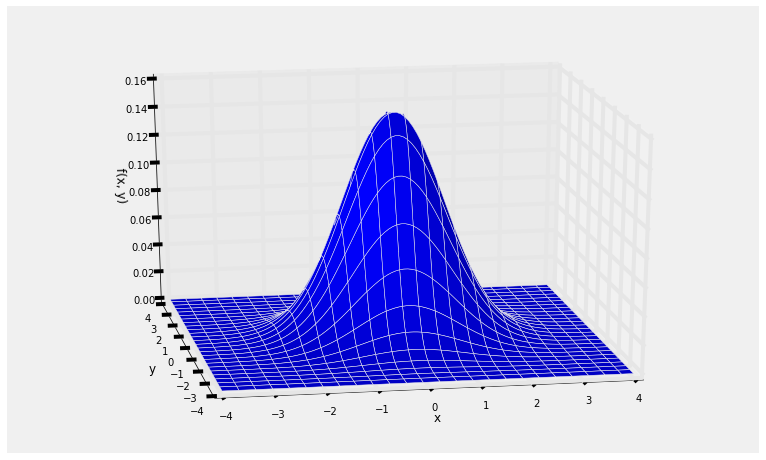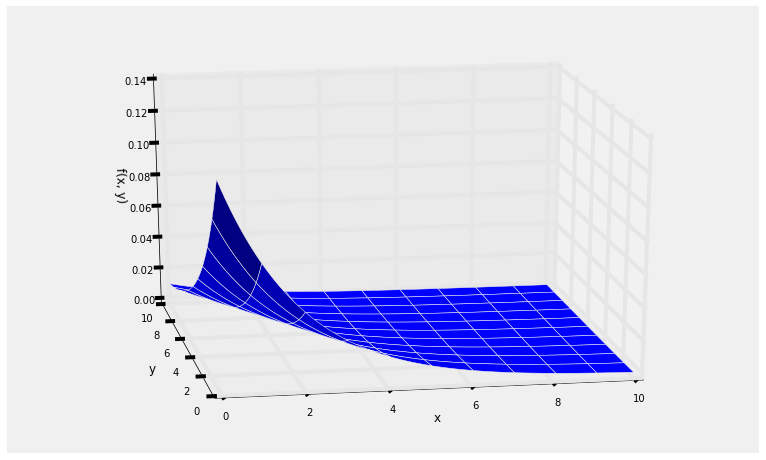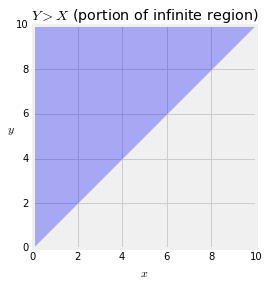Independence
Independence¶
Random variables $X$ and $Y$ are independent if $$ P(X \in A, Y \in B) = P(X \in A)P(Y \in B) $$ for all intervals $A$ and $B$.
Let $X$ have density $f_X$, let $Y$ have density $f_Y$, and suppose $X$ and $Y$ are independent. Then if $f$ is the joint density of $X$ and $Y$,
\begin{align*} f(x, y)dxdy &\sim P(X \in dx, Y \in dy) \\ &= P(X \in dx)P(Y \in dy) ~~~~~ \text{(independence)} \\ &= f_X(x)dx f_Y(y)dy \\ &= f_X(x)f_Y(y)dxdy \end{align*}Thus if $X$ and $Y$ are independent then their joint density is given by
$$ f(x, y) = f_X(x)f_Y(y) $$This is the product rule for densities: the joint density of two independent random variables is the product of their densities.
Two Independent Normal Random Variables¶
For example, suppose $X$ and $Y$ are i.i.d. standard normal random variables. Then their joint density is given by
$$ f(x, y) = \frac{1}{\sqrt{2\pi}} e^{-\frac{1}{2}x^2} \cdot \frac{1}{\sqrt{2\pi}} e^{-\frac{1}{2}y^2}, ~~~~ -\infty < x, y < \infty $$Equivalently, $$ f(x, y) = \frac{1}{2\pi} e^{-\frac{1}{2}(x^2 + y^2)}, ~~~~ -\infty < x, y < \infty $$
Here is a graph of the joint density surface.
def indep_standard_normals(x,y):
return 1/(2*math.pi) * np.exp(-0.5*(x**2 + y**2))
Plot_3d((-4, 4), (-4, 4), indep_standard_normals, rstride=4, cstride=4)
Notice the circular symmetry of the surface. This is because the formula for the joint density involves the pair $(x, y)$ through the expression $x^2 + y^2$.
Notice also that $P(X = Y) = 0$, as the probability is the volume over a line. This is true of all pairs of independent random variables with a joint density: $P(X = Y) = 0$. So for example $P(X > Y) = P(X \ge Y)$. You don't have to worry about whether or not to the inequality should be strict.
The Larger of Two Independent Exponential Random Variables¶
Let $X$ and $Y$ be independent random variables. Suppose $X$ has the exponential $(\lambda)$ distribution $Y$ has the exponential $(\mu)$ distribution. The goal of this example is to find $P(Y > X)$.
By the product rule, the joint density of $X$ and $Y$ is given by
$$ f(x, y) ~ = ~ \lambda e^{\lambda x} \mu e^{-\mu y}, ~~~~ x > 0, ~ y > 0 $$The graph below shows the joint density surface in the case $\lambda = 0.5$ and $\mu = 0.25$, so that $E(X) = 2$ and $E(Y) = 4$.
def independent_exp(x, y):
return 0.5 * 0.25 * np.e**(-0.5*x - 0.25*y)
Plot_3d((0, 10), (0, 10), independent_exp)
To find $P(Y > X)$ we must integrate the joint density over the upper triangle of the first quadrant, a portion of which is shown below.
The probability is therefore $$ P(Y > X) ~ = ~ \int_0^\infty \int_x^\infty \lambda e^{-\lambda x} \mu e^{-\mu y} dy dx $$
Let's do this in SymPy and then take another look at the calculation. Notice that SymPy doesn't want to write the joint density with negative exponents.
declare('x', 'y', 'lamda', 'mu', positive=True)
f_X = lamda * exp(-lamda * x)
f_Y = mu * exp(-mu * y)
jt_density = f_X * f_Y
jt_density
p_Y_greater_than_X = Integral(jt_density, (y, x, oo), (x, 0, oo))
p_Y_greater_than_X
p_Y_greater_than_X.doit()
Easy algebra, or the rearrange_1 algebraic simplification method, provides an alterative form of the answer:
rearrange_1(p_Y_greater_than_X.doit())
Thus $$ P(Y > X) ~ = ~ \frac{\lambda}{\lambda + \mu} $$ Analogously, $$ P(X > Y) ~ = ~ \frac{\mu}{\lambda + \mu} $$
Notice that the two chances are proportional to the parameters. This is consistent with intuition if you think of $X$ and $Y$ as two lifetimes. If $\lambda$ is large, the corresponding lifetime $X$ is likely to be short, and therefore $Y$ is likely to be larger than $X$ as the formula implies.
If $\lambda = \mu$ then $P(Y > X) = 1/2$ which you can see by symmetry since $P(X = Y) = 0$.
It's instructive to do the integral for calculating $P(Y > X)$ without resorting to SymPy. The calculation shows how you can use probability theory to do calculus.


